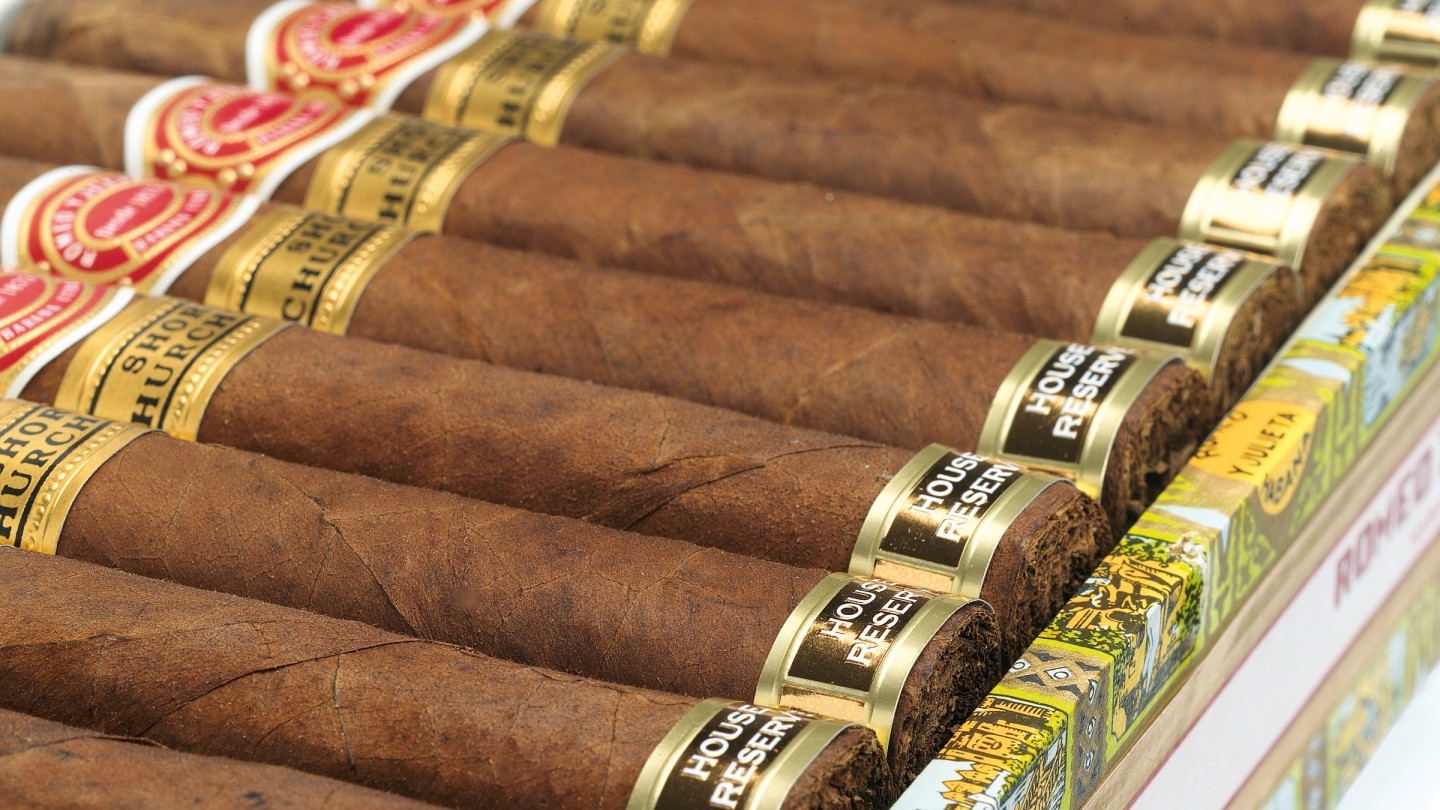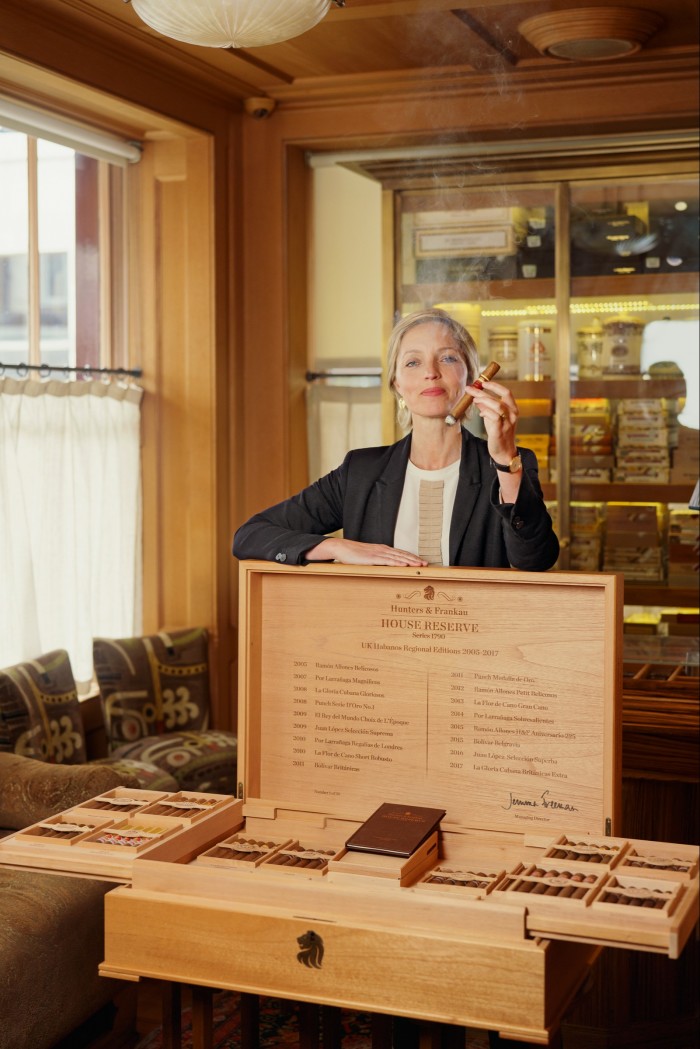A cache of long-lost cigars from Hunters & Frankau

Roula Khalaf, Editor of the FT, selects her favourite stories in this weekly newsletter.
New old stock: three words, an oxymoron, and every vintage collector’s dream. The idea that a much sought-after collectable has been languishing at the back of the safe, lying in a bottom drawer or lurking in a far corner of the warehouse, only to be rediscovered years – decades – after it ceased production, is a seductive one: at once factory-fresh and long discontinued, with impeccable provenance and the bonus of not having passed through the hands of numerous collectors. Clothes, watches, car parts… the list of NOS items is long, and it now includes cigars.
This summer, Cuban-cigar importer Hunters & Frankau released its first batch of House Reserve cigars. As with winemakers who keep their rarest vintages in locked and barred treasure rooms, so Hunters & Frankau has also been setting aside special boxes of cigars. Now it has decided to make small numbers of these cigars available to specialist retailers.
It is, in effect, a diary, in Vuelta Abajo tobacco, of the past 20 or so years – a period that has seen the world of Havana cigars change dramatically. The once leisurely pace at which new cigars were introduced and old ones discontinued has quickened. New brands launched at the end of the 1990s, including San Cristóbal, Trinidad, Cuaba and Vegas Robaina, have now established themselves. A plethora of new vitolas has appeared in ever heavier ring gauges. During the 1990s, a 40-ring gauge was considered “standard”; now anything under 50 looks almost emaciated, and changing patterns of cigar smoking have favoured shorter, chunkier sizes that can be enjoyed in a short time. In addition to new brands and new sizes, there are now all manner of special releases: limited editions, regional editions and commemorative editions, as well as the celebrated Reservas and Gran Reservas – each of which has its own protocols regarding vitolas, distribution, minimum age of tobacco leaf, and so on. Seen in this context, the idea of establishing House Reserve was far-sighted to the point of clairvoyance.
Moreover, during that time the fascination with aged cigars has exploded. Edición Limitada cigars are made with tobacco that is a minimum of two years old; Reserva has an age threshold of three years; and Gran Reserva uses leaf that is five or more years old. But these ages apply to leaves that are then blended and rolled rather than finished cigars.
When it comes to aged finished Havana cigars, the UK, not Cuba, is the place to look. London’s cigar merchants, in particular, lead the world – whether the sophisticated climate-control system in the ageing room of Birley Cigars, the regular auctions of vintage cigars held by Mitchell Orchant’s C.Gars, or the Edward Sahakian special reserve, named in honour of the proprietor of Davidoff of London, which offers rare cigars that have been stored in the firm’s vaults, in some instances since they opened in 1980. It is through these and other skilled merchants that Hunters & Frankau will be selling House Reserve cigars.

House Reserve is the creation of Jemma Freeman, who joined the 229-year-old family-owned cigar importer in 2001. “In my father’s day, the collapse of the USSR caused shortages which, combined with a huge boom in demand, made it difficult for him to build up any meaningful reserves,” she says. But by the end of the century, conditions were easier and demand dipped, so when she became managing director of the company in 2005, she realised that there were cigars that were barely selling at all. “They had just fallen off the radar; cabinets of 50 were not moving, nor were longer cigars such as Double Coronas and Churchills. At one time our stock control was showing that we had 999 years’ supply of Sancho Panza Sanchos” – an unwieldy nine-inch broomstick of a cigar. “In other words, we weren’t selling any,” she says. “So we went to the warehouse, selected a few to taste and found they were delicious.”
Rather than focusing on big names and classic sizes, she began setting aside interesting cigars and established a set of criteria that reflects scarcity as well as maturity. There are three age groups: those that are 10 or more years old, 15 years or older, and then cigars that are over 20. “But it’s not just their age that makes House Reserve cigars especially rare. Some were among the very first of a new vitola ever to be produced in Cuba. Cigars made in the year when the vitola was launched are known as First Releases and are particularly prized among collectors.” Similarly sought after are discontinued shapes and sizes. And then there are the Havanas that were only ever manufactured in deliberately restricted quantities: limited editions, Reservas and Gran Reservas, and regional editions.

Each box is stamped “revisado”, meaning that every cigar has been inspected by a Cuban quality-control expert who spent three months at the warehouse, and carries a gold band at its foot proudly proclaiming itself as House Reserve. As well as adding a little bling, this protects the cut end of the cigar from fraying.
In its first year, House Reserve is headlining with boxes of Cohiba Siglo VI (£900 for 10) from the first shipment that landed in the UK in 2003. If I were ever faced with the dilemma of being restricted to one cigar for the rest of my life, it would be this one: all the complexity and flavour you expect from a Cohiba and, with a length of almost six inches, the time for it to develop. Mirabile dictu, its 52-ring gauge now almost standard, was the widest straight-sided cigar in Cuba at the time of its launch.

If, however, straight-sided cigars are not your thing, then you will be delighted by the Cuaba Diademas (£372 for five), the most eccentric of the batch. At just over nine inches in length and swelling to a maximum ring-gauge girth of 55 before tapering again to its end, this is a cigar that thinks it is a zeppelin. What is more, when lit it emits a scimitar-shaped flame. But size and pyrotechnics aside, it is worth remembering that only the highest-graded rollers are permitted to make figurados (shaped cigars), so the construction should be among the best you’ve encountered.
The greatest curiosity is the variety box of different sizes of Cohiba Selección Reserva (£2,940 for 50) released in 2003. They should have been brilliant, but I remember not thinking too highly of them at the time, so it will be interesting to see if I like them better on renewed acquaintance (or whether my palate is more sophisticated).

But it is not merely about famous names, unusual sizes and strange selections. There is something for most tastes: from the elegant, wand-like – and, alas, discontinued – Hoyo de Monterrey Le Hoyo du Dauphin (£1,200 for 25), dating from the late 1990s, to the meaty, punchy Bolivar Coronas Gigantes, again from the late 1990s – a treat for collectors in that they come in cabinets of 50 (£3,350). And the joy of the selection is that one encounters half-forgotten treasures such as the San Cristóbal de la Habana Mercaderes (£1,168 for 25) – launched in 2004, discontinued in 2011 – which, based on this sensational House Reserve, should be restored to production immediately. Complex, nutty and toasted mouth-filling flavours abound; the intervening years have worked a delicious magic on this rare cigar from an underappreciated brand.
At the same time as releasing boxes of all the aforementioned, Hunters & Frankau will also be launching the first Series 1790 (£58,800), a themed collection of cigars housed in a specially built humidor that this year contains 170 cigars, 10 each of all the special edition Havana cigars made for the UK market only since 2005. It is a collection that would be almost impossible to assemble today. So it is astonishing that there are 30 of these humidors available.
It makes me wonder what else Hunters has knocking around the warehouse. On the basis of just this year’s House Reserve, by comparison Ali Baba’s cave or Tutankhamun’s tomb seem positively disappointing.
Birley Cigars, 6A Trebeck Street, London W1 (020-7408 7317; birleycigars.com). C.Gars, 16-18 Kingsgate Place, London NW6 (020‑7372 1865; cgarsltd.co.uk). Davidoff of London, 35 St James’s Street, London SW1 (020-7930 3079; davidofflondon.com). Edward Sahakian Cigar Shop & Sampling Lounge, Bulgari Hotel London, 171 Knightsbridge, London SW7 (020-7151 1010; bulgarihotels.com). Hunters & Frankau, 16-19 Hurlingham Business Park, Sulivan Road, London SW6 (020-7471 8444; cigars.co.uk).
Comments